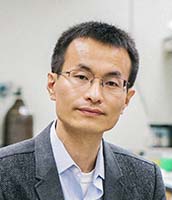Can we create ‘liquid sunlight’?
No single clean energy technology can rein in carbon dioxide emissions. Researchers at the Berkeley Lab aim to add artificial synthesis to our renewable energy portfolio. The technology uses sunlight to turn CO2 and water into chemical fuels. Over the past decade, research led by Peidong Yang has yielded new classes of semiconductor materials to efficiently capture sunlight for this process, and new types of catalysts to promote the chemical reactions. His team recently reached a milestone, demonstrating a process in which sunlight shines into a water solution bubbled with CO2 to produce chemical fuels, polymers and under some conditions, even pharmaceutical intermediates to make drugs. The prototype system converts solar to chemical energy at a higher efficiency than nature. Hurdles remain, but one day, he says, we may fill the gas tank not with fossil fuels, but with liquid sunlight.
 Peidong Yang
Peidong Yang
Peidong is an inorganic chemist transforming the field of semiconductor nanowires and nanowire photonics and enabling wide-ranging practical applications. He has led major breakthroughs in nanowire photonics over the last decade, from the initial development of nanowire lasers to the characterization of optical routing in nanowire assemblies and nanowire solar cells. Read more.
